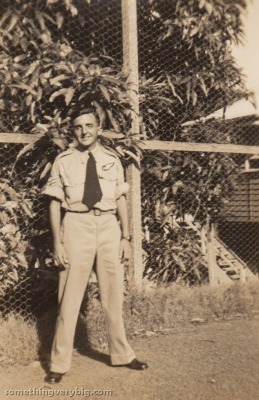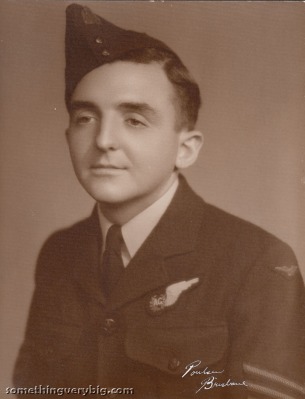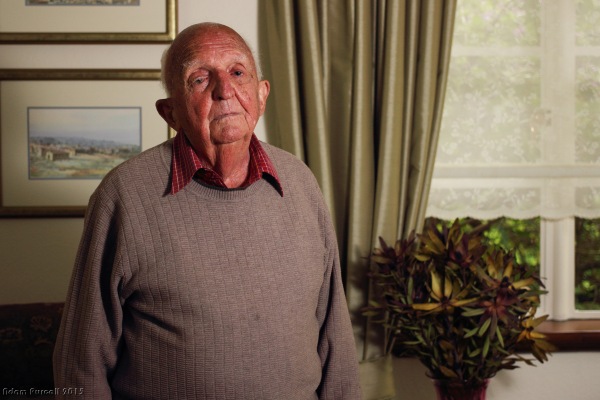You had to be lucky to survive a tour in Bomber Command at any time during WWII. But you had to be really lucky to survive a tour if you were operating in the winter of 1943-44, when the Battle of Berlin was at its height and the RAF were losing upwards of 30 or 40 aircraft a night.
A 21-year-old Australian named Joe Shuttleworth got lucky while heading to Berlin in the rear turret of a 50 Squadron Lancaster on 15 February 1944. It’s fair to say it would not have felt much like a stroke of luck at the time. “There was a flash about 11 o’clock high,” he told me when I interviewed him for the International Bomber Command Centre’s Digital Archive late last year. “I felt immediate pain…”
That was some time off, however, when a very young Joe Shuttleworth saw Bert Hinkler land at Brisbane’s Eagle Farm racecourse in 1930. Like many of his generation, that inspired an interest in flying so it was only natural that he would join the Royal Australian Air Force when war broke out. Unfortunately Joe had a deficiency in one eye which precluded him from becoming a pilot, but he was accepted as a Wireless Air Gunner and after training and receiving his gunner’s brevet in Australia he embarked for war.

Joe travelled across the Pacific Ocean, then across the US by train. He was very impressed with the trip. The scenery on the way was very nice, and he had “the biggest icecream of my life” in Salt Lake City. England was pretty alright too. “Lovely country”, he said.
“Lots of beautiful girls, lots of warm beer – it was pretty hard to get cold beer in those days – but the countryside was absolutely beautiful.”
Joe completed further training at 29 Operational Training Unit at Bruntingthorpe, where he survived a crash in a Wellington after a tyre burst on take-off. But something else happened while he was at Bruntingthorpe: something with far further-reaching consequences for Joe’s life.
Nearby the airfield was the village of Lutterworth. Having been to a party in the village one night, Joe was walking around the town when two girls came up. One of them asked if Joe had any change. He was able to oblige her, but it was the other girl, named Freda, who caught Joe’s eye.
“Of late I have been going out on a few occasions with a Lands Army girl (and very nice too I may mention)”, he subsequently wrote home in July 1943. “And here’s another tip, don’t jump to all kinds of conclusions!”
I know this because Joe let me borrow, to scan for the Archive, a wonderful collection of letters from his time overseas. There’s more than 40 all up, and in letters from the second half of 1943 there are plenty of mentions of “my little Lands Army girl friend.” So any conclusions to which his family may have jumped actually turned out to be correct: Joe and Freda became engaged during a leave in November and, on 30 December 1943, they married. I asked Joe what a wartime wedding was like. “We toasted with a bottle of Australian wine”, he said. “How it happened to be there I’m not quite sure, but it was there!”

Joe and his crew were posted to Skellingthorpe on 15 January 1944. Over the next month the 50 Squadron Operational Record Book records Joe’s name against five operational flights. All five of them were against the same target.
Berlin.
“We’d be sending out about 750 aircraft [a night”, he said. “We’d generally lose about 50. So on a tour of 30, statistically it’s impossible to get through.” For Joe and his crew, though, things went relatively smoothly. After each raid they landed successfully at Skellingthorpe, feeling very relieved and thinking, “there’s another one towards the 30.” Everything went smoothly, that is, until that fateful night in February 1944 when Joe met his Waterloo.
The flash he saw in his turret on the way to Berlin was, Joe now thinks, the result of an attack by a nightfighter equipped with the as-yet-unsuspected upwards-firing Schrage Musik cannon. His turret was wrecked and he was badly wounded. “I think one of the crew dragged me out of the turret”, he told me, though there is a letter in the collection that suggests he actually insisted that he remained in the turret until they returned to Skellingthorpe. He did not lose consciousness until he arrived at the RAF hospital at Rauceby.
So what were Joe’s injuries? At this point, I’ll quote from what is probably the most poignant letter amongst the collection, written by Joe’s new wife Freda to his cousin Keith, who was serving in the Royal Australian Navy in London at the time. Understandably, Freda beats around the bush for a page and a half first.
Excuse me Keith for going all round to get to the point, but you see, I just can’t put into words the thing that is so hard to grasp. I hope it won’t give you too much of a shock Keith – he has had his right eye out and has also fractured his right arm.”
Joe was the only man on his crew to be injured in the attack, and his turret was the only part of the Lancaster to be damaged. This probably felt like some rather bad luck at the time. But as it turned out, the eye that Joe lost was the bodgy one that had precluded him from pilot training. And with Keith’s support Freda remained relatively upbeat. Even though the surviving letters tell a tale of grief and uncertainty they also reveal a determination to keep positive about the future. As Freda wrote at one point, “From all the horror of this, I have one great consolation, this is, he will not be flying again.”
She was right. Once he had left hospital, Joe spent some months working in the office at RAAF Headquarters in Kodak House, London, before he came home via the United States towards the end of 1944. Freda followed him to Australia a year later.
As we approached the end of the interview I asked Joe what he thought about his time in Bomber Command. “Great experience,” he said without hesitation. “Great experience. I had a world trip… I saw places I’ve never been back to.” Indeed, since he returned from the war he has not once left Australia.
After Joe was removed from operational flying, the rest of his crew carried on. On 3 May 1944, they were in one of 42 aircraft that failed to return from the disastrous attack on the German Panzer depot at Mailly-le-Camp[1].
“I was one of the lucky ones,” Joe said, very quietly.

Text and colour photograph © 2016 Adam Purcell. Wartime images used courtesy Joe Shuttleworth
[1] Thanks to Mike Connock of the 50 Squadron Association for copies of the Squadron’s Operational Record Books

Having been brought up close to Bitteswell and Lutterworth, I know it well. A really interesting man and a wonderful record. Thank you for sharing it.